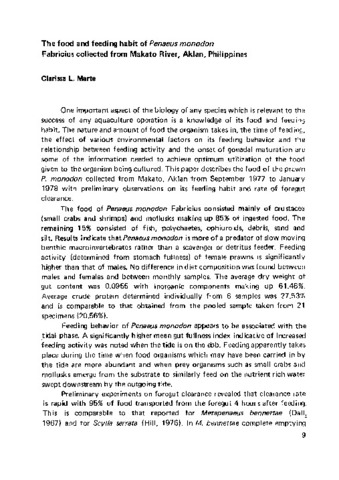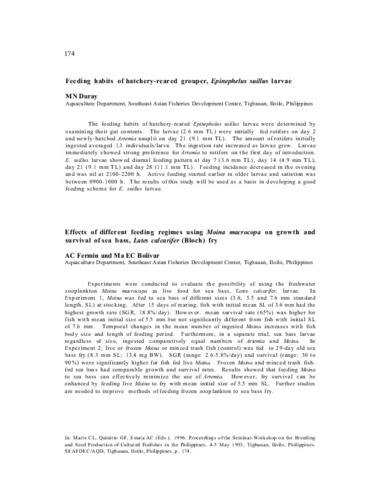Contribution of natural food and supplemental feed to the gut content of Penaeus monodon Fabricius in a semi-intensive pond system in the Philippines
- Global styles
- MLA
- Vancouver
- Elsevier - Harvard
- APA
- Help

ดู/
วันที่
1998Page views
4,918ASFA keyword
AGROVOC keyword
Taxonomic term
เมตาดาต้า
แสดงระเบียนรายการเต็ม
Share
นามธรรม
Juvenile Penaeus monodon were stocked in grow-out ponds and fed a compound diet at high rates for 19 weeks under semi-intensive conditions. At three stages of the rearing period (weeks 6, 11 and 16), the gut content of the shrimp was analysed microscopically at every hour of the day. Additionally, possible sources of natural food (lablab, lumut, zoobenthos, etc.) were analysed microscopically and where possible for proximate composition. At week 6, the gut content consisted of 28.9% supplemental feed, 42.3% plant materials (other than from the pelleted diet), 1.8% crustacean parts and 27.0% diverse detrital matter. For week 11, the percentages (same order) were 47.5%, 21.1%, 22.8%, 8.6% and for week 16, 21.7%, 34.3%, 31.7% and 12.9%, respectively. Food preference did not change with time of the day. At week 6, most feeding activity occurred at night, later, feeding activity shifted to day-time. Reduction of the maximum gut content at dissolved oxygen levels below 4 mg l−1 at night indicated a cessation of feeding in which case shrimp fed during the day-time, when dissolved oxygen levels were higher.
การอ้างอิง
Focken, U., Groth, A., Coloso, R. M., & Becker, K. (1998). Contribution of natural food and supplemental feed to the gut content of Penaeus monodon Fabricius in a semi-intensive pond system in the Philippines. Aquaculture , 164(1-4), 105-116. https://doi.org/10.1016/S0044-8486(98)00180-X
Type
ArticleISSN
0044-8486คอลเลกชัน
- Journal Articles [1256]
Related items
Showing items related by title, author, creator and subject.
-
Production of Penaeus monodon (Fabricius) using four natural food types in an extensive system
Bombeo-Tuburan, I.; Guanzon, Nicholas G., Jr.; Schroeder, G. L. (Elsevier, 1993)Growth, survival, and production of P. monodon feeding on four types of natural food, i.e., lablab (benthic mat of cyanobacteria, diatoms, and associated fauna), Ruppia maritima, lumut (filamentous green algae and attached ... -
The food and feeding habit of Penaeus monodon Fabricius collected from Makato River, Aklan, Philippines
Marte, Clarissa L. (Aquaculture Department, Southeast Asian Fisheries Development Center, 1978)The food of Penaeus monodon collected from Makato R., from Sept 1977 to Jan 1978 is described with preliminary observations on its feeding habit and rate of foregut clearance. Feeding behaviour appears to be associated ... -
Feeding habits of hatchery-reared grouper, Epinephelus suillus larvae
Duray, Marietta N. (Aquaculture Department, Southeast Asian Fisheries Development Center, 1996)The feeding habits of hatchery-reared Epinephelus suillus larvae were determined by examining their gut contents. The larvae (2.6 mm TL) were initially fed rotifers on day 2 and newly-hatched Artemia nauplii on day 21 (9.1 ...





